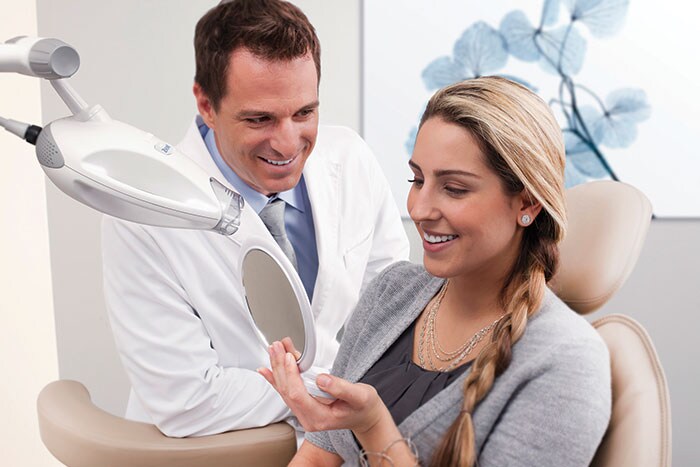Blog
Improving lives with digital and patient-centric oral healthcare solutions: a dentist’s perspective
During my many years working as a dentist, I have seen the terrible impacts that gum disease can have on people’s lives. Excessive bleeding, nagging pain and, if left untreated, loss of teeth. It is an epidemic. It’s a chronic, inflammatory disease that also interferes with the quality of life of those affected, because it has functional, physical, psychological, and social impacts.
The late stage of gum disease, or periodontitis, is irreversible: once it hits, it requires life-long maintenance—and it’s expensive. In the US, for example, a periodontal treatment can cost a patient thousands of dollars. Unlike with some other diseases, people with gum disease do not want to speak about it. They feel ashamed because it is primarily caused by poor oral hygiene. What’s more, the mouth is the gateway to the body. There is robust evidence on the link between gum disease and systemic conditions, such as cardiovascular diseases, and diabetes1,2. Resolving this prevalent global disease, which affects up to 50% of the world’s population, and improving people’s oral healthcare in general, is what drove me to pursue a PhD and to continue my clinical scientific work here within Philips Research. Working everyday on finding and providing solutions that can help people suffering from gum disease and other oral health complications, gives me motivation and makes me proud. I believe that our work can and will make a big difference in the quality of lives of people who suffer. Even if I personally can help a small portion of the population—that is fulfilling.
Working everyday on finding and providing solutions that can help people suffering from gum disease and other oral health complications, gives me motivation and makes me proud.
Empowering people to improve their health
While Philips is already a leader in the oral healthcare domain, I believe that our work at Philips Research is essential for cementing that leadership position. Philips Research is co-steering the company to serve the needs of an increasingly digital-minded consumer base. Together with our multidisciplinary team of scientists, engineers, software architects, designers, technicians, physicians, and business developers, we are researching ways to digitize the way people use our products.

For instance, we know that consumers have difficulties adhering to, and maintaining, the daily oral hygiene routine as recommended by their dental professionals. I can give you a simple example: most people don’t brush for the recommended two minutes, twice a day and many miss spots in their mouth when they do brush, especially in the back of the mouth where problems often begin. Therefore, we research and design products to tailor them to the needs of the consumers, helping them to get excited and motivated to use the product, as recommended, and to achieve optimal results. This also means we are able to provide consumers with the information they need to make better healthcare decisions. With greater personal connectivity possible through easy-to-use apps—available with our oral healthcare products, such as the Connected Toothbrush—we’re now able to better guide consumers in their brushing methods and to allow them to see their blind spots. From my experience, we also know that people will often change their behavior when they see the consequences that follow. We’re using connectivity and data to show people exactly how they can take care of their health and offer recommendations for actions they can take to improve their health. Our consumer data shows us that those individuals who use the Connected Toothbrush and app, for example, brush longer than those who do not. As a dentist, I find it rewarding to be part of the team that develops innovations to meet the real needs of people.
As a dentist, I find it rewarding to be part of the team that develops innovations to meet the real needs of people.
Dentistry advice when you need it
Another way that we are helping people address their oral healthcare issues is by digitizing oral healthcare solutions and putting information and control into consumers’ hands. We are launching a teledentistry platform, for instance, which we’ll showcase at the IFA 2018 in Berlin. What the Philips Sonicare Solutions teledentistry service does is transform our existing Philips Sonicare app into a comprehensive hub of data, advice and services, giving consumers better access to care and peace of mind when it comes to their oral health. The platform enables consumers to get reliable expert advice from licensed dentists at their fingertips in the comfort of their homes or wherever they happen to be at the time. Like all of the Philips oral healthcare products, I think this platform clearly illustrates our commitment to evidence-based dentistry and to making sure that people’s oral healthcare doesn’t begin or end when they leave the chair at a dentist’s clinic. By adding digital elements to our products and care, I trust we can reassure and enable people to make healthier lifestyle choices and lead better lives, which is something I’m very proud of and inspired to contribute to when I enter the office every day. If you’d like to find out more about our research work on oral healthcare, visit Philips in hall 22, from August 31 to September 5, 2018 in Berlin.
References:
1 Periodontitis and diabetes: a two-way relationship. P. M. Preshaw, A. L. Alba, D. Herrera, S. Jepsen, A. Konstantinidis, K. Makrilakis, R. Taylor Diabetologia. 2012 Jan; 55(1): 21–31. Published online 2011 Nov 6. doi: 10.1007/s00125-011-2342-y 2 Lafon A, Pereira B, Dufour T, et al. Periodontal disease and stroke: a meta-analysis of cohort studies. Eur J Neurol 2014;21:1155-61.
Author

Amir Rmaile Connect with Amir on:
Clinical Scientist at Philips Research
Amir believes that innovation is key for a healthier mouth. His passion is to derive new solutions from patients’ needs.
